When learning a new language, whether it’s Chinese or any other language, understanding and using time expressions correctly is an essential skill. The following article from Ni Hao Ma will guide you on telling time in Chinese, helping you communicate more effectively in everyday situations.
Vocabulary for Time in Chinese
Mastering the vocabulary related to time will make it easier for you to communicate in daily situations, such as asking for the time, scheduling work meetings or setting appointments.
Vocabulary for Time Units
When learning to tell time in Chinese, it’s essential to know the vocabulary for different time units. Below are some common time-related terms in both English and Chinese:
| English | Chinese | Pinyin |
|---|---|---|
| Second | 秒 | miǎo |
| Minute | 分钟 | fēn zhōng |
| Hour | 小时 | xiǎo shí |
| Day | 天 | tiān |
| Week | 星期 | xīngqī |
| Month | 月 | yuè |
| Year | 年 | nián |
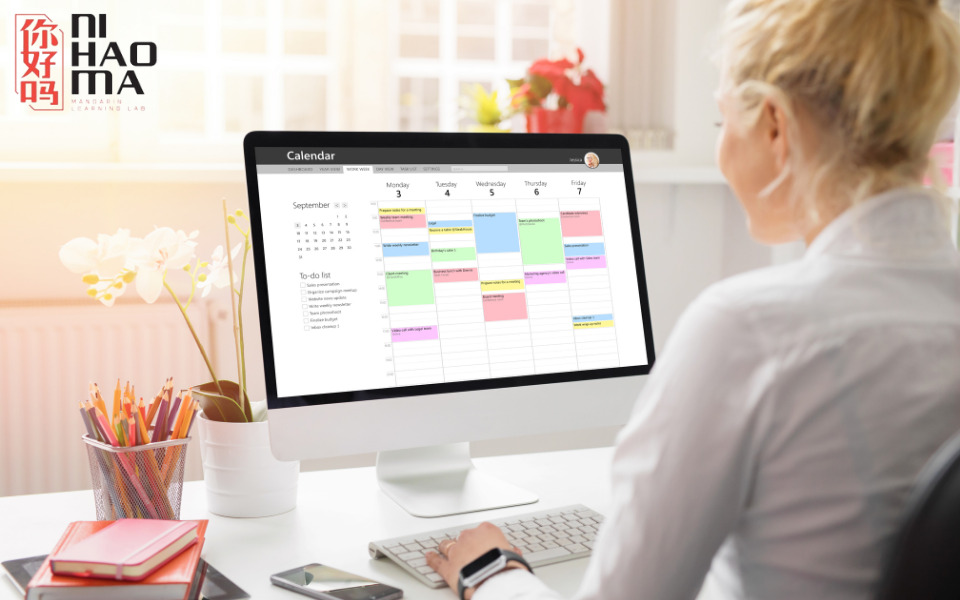
Time Markers in the Day
| English | Chinese | Pinyin |
|---|---|---|
| Morning | 早上 | zǎo shàng |
| Noon | 中午 | zhōng wǔ |
| Afternoon | 下午 | xià wǔ |
| Evening | 晚上 | wǎn shàng |
| Midnight | 半夜 | bàn yè |
Specific Time Expressions
| English | Chinese | Pinyin |
|---|---|---|
| Today | 今天 | jīn tiān |
| Yesterday | 昨天 | zuó tiān |
| Tomorrow | 明天 | míng tiān |
| Last week | 上周 | shàng zhōu |
| Next week | 下周 | xià zhōu |
| Last month | 上个月 | shàng ge yuè |
| Next month | 下个月 | xià ge yuè |
| Last year | 去年 | qù nián |
| Next year | 明年 | míng nián |
| Before | 以前 | yǐ qián |
| After | 以后 | yǐ hòu |
| Right now | 现在 | xiàn zài |
| Soon | 快要 | kuài yào |
| Just now | 刚才 | gāng cái |
Telling Time in Chinese
Telling time in Chinese is not too complicated, but it’s important to understand the correct vocabulary and sentence structure. In this section, we’ll guide you through how to tell time in Chinese in detail, so keep reading!
Telling the Exact Hour in Chinese
When telling the exact time without minutes, it’s quite simple. You just need to follow this structure:
Number + 点 (diǎn)
Here are some examples of telling the exact hour in Chinese:
- 现在五点 (Xiànzài wǔ diǎn) – It’s 5 o’clock.
- 八点 (Bā diǎn) – It’s 8 o’clock.
- 九点 (Jiǔ diǎn) – It’s 9 o’clock.
- 两点 (Liǎng diǎn) – It’s 2 o’clock (Note: In Chinese, 两 (liǎng) is used instead of 二 (èr) to refer to the number 2 when telling time).
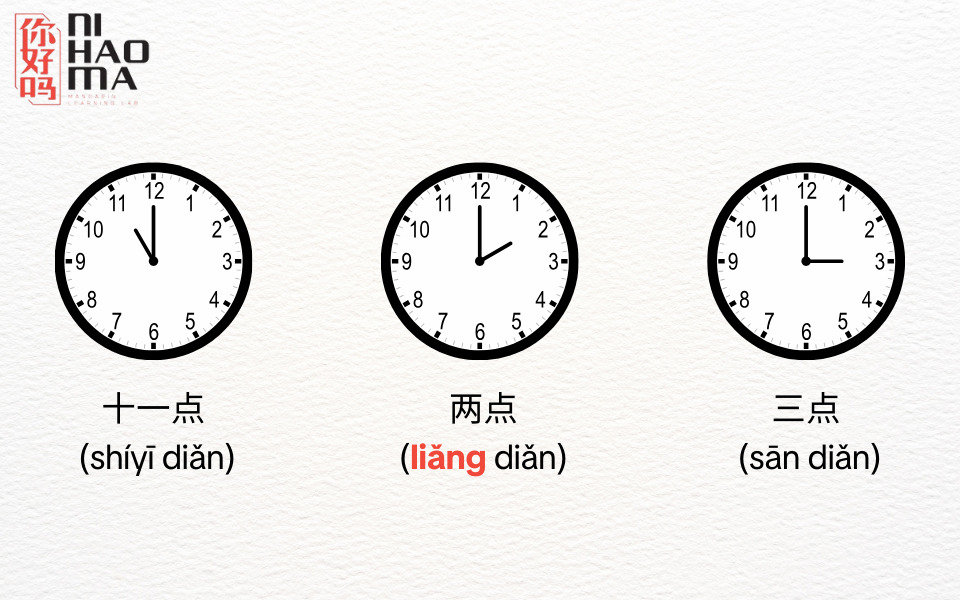
You can add the word 整 (zhěng) to emphasize that it’s exactly on the hour, such as:
现在七点整。 (Xiànzài qī diǎn zhěng.) – It’s exactly 7 o’clock.
Explore more: Everything About Numbers In Chinese
How to tell time in Chinese: Hours, Minutes, and Seconds
When telling time in Chinese, it’s important to understand how to express the basic components of time: hours, minutes, and sometimes seconds. The structure for telling time in Chinese typically follows this pattern:
… 点 (diǎn) + … 分 (fēn) + … 秒 (miǎo)
For example, here’s how you can tell time in Chinese, including hours, minutes, and seconds:
现在是两点三十分十五秒。
(Xiànzài shì liǎng diǎn sān shí fēn shí wǔ miǎo.)
It’s 2:30:15.
现在是四点十五分四十五秒。
(Xiànzài shì sì diǎn shí wǔ fēn sì shí wǔ miǎo.)
It’s 4:15:45.
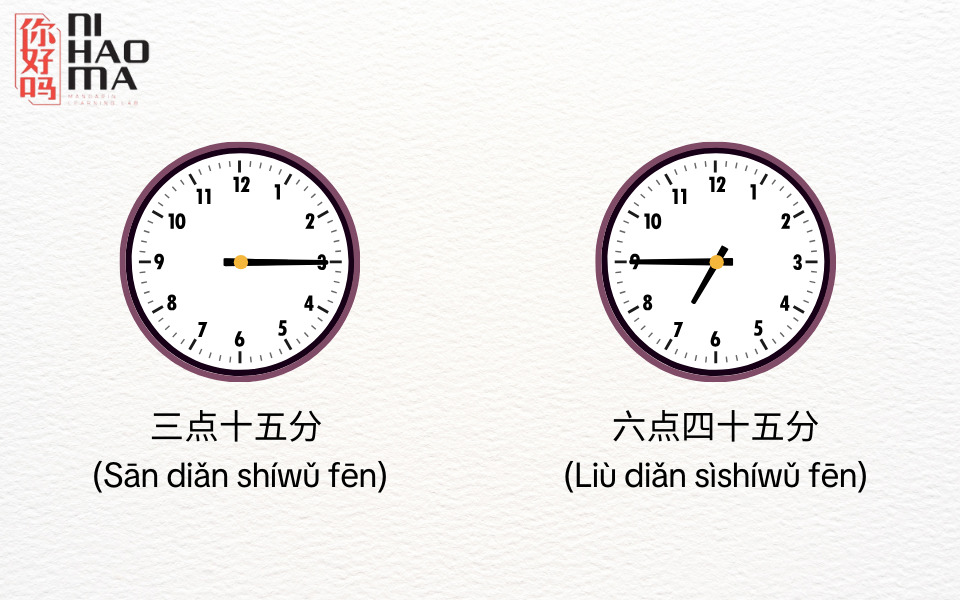
How to Tell Time in Chinese: Half Past and Quarter To
In addition to the full structure of hours and minutes, there are other ways of telling time in Chinese, such as using “half past” or “quarter to.”
Half Past – Using 半 (Bàn)
To say “half past” in Chinese, simply add 半 (bàn) after the hour number:
Number + 点 (diǎn) + 半 (bàn)
Examples:
- 四点半。(sì diǎn bàn) – 4:30
- 七点半。(qī diǎn bàn) – 7:30
- 十点半。(shí diǎn bàn) – 10:30
Quarter To – Using 差 (Chà)
The word 差 (chà) in Chinese means “to be less” or “to lack.” To say “quarter to” in Chinese, you use the following structure:
Next hour number + 点 (diǎn) + 差 (chà) + number of minutes + 分 (fēn)
Examples:
- 五点差十分。(wǔ diǎn chà shí fēn) – 10 minutes to 5
- 九点差一刻。(jiǔ diǎn chà yí kè) – 15 minutes to 9
- 六点差五分。(liù diǎn chà wǔ fēn) – 5 minutes to 6
In Chinese, time expressions are often further clarified by adding time-of-day indicators before the hour. For example:
- 8:00 AM → 早上八点 (zǎoshang bā diǎn)
- 3:30 PM → 下午三点半 (xiàwǔ sān diǎn bàn)
- 9:45 PM → 晚上九点四十五分 (wǎnshang jiǔ diǎn sì shí wǔ fēn)
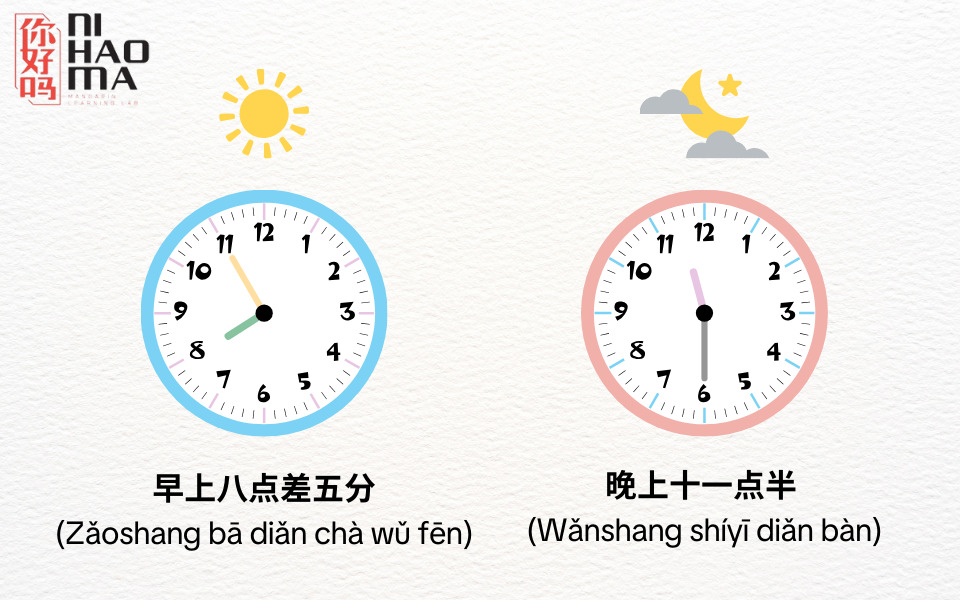
How to Ask for the Time in Chinese
When learning to tell time in Chinese, it’s important to know how to ask for the time correctly. Below are some common phrases used to inquire about the time in Chinese:
| English | Chinese | Pinyin |
|---|---|---|
| What time is it now? | 现在几点钟 | Xiànzài jǐ diǎn? |
| What time is it now? | 现在是什么时间? | Xiànzài shì shénme shíjiān? |
| What time is it, including minutes? | 现在几点几分? | Xiànzài jǐ diǎn jǐ fēn? |
| Excuse me, what time is it now? | 请问, 现在几点? | Qǐng wèn, xiànzài jǐ diǎn? |
| Do you know what time it is? | 你知道现在几点吗? | Nǐ zhī dào xiànzài jǐ diǎn ma? |
| Could you tell me the time? | 你可以告诉我现在几点吗? | Nǐ kěyǐ gàosù wǒ xiànzài jǐ diǎn ma? |
Telling Duration in Chinese
When talking about time durations in Chinese, these phrases are quite simple and commonly used in daily conversations:
| English | Chinese | Pinyin |
|---|---|---|
| From what time to what time? | 从几点到几点? | Cóng jǐ diǎn dào jǐ diǎn? |
| How long does it take? | 需要多长时间? | Xūyào duō cháng shíjiān? |
| How long has it been? | 多久了? | Duōjiǔ le? |
| Excuse me, what time is it now? | 请问, 现在几点? | Qǐng wèn, xiànzài jǐ diǎn? |
| When does it start? | 什么时候开始? | Shénme shíhou kāishǐ? |
| When does it end? | 什么时候结束? | Shénme shíhou jiéshù? |

Examples:
A: 现在几点了? (Xiànzài jǐ diǎn le?) – What time is it now?
B: 现在三点十五分。 (Xiànzài sān diǎn shíwǔ fēn.) – It’s 3:15.
A: 这个会议多长时间? (Zhège huìyì duō cháng shíjiān?) – How long is this meeting?
B: 大约两个小时。 (Dàyuē liǎng gè xiǎoshí.) – About 2 hours.
A: 你学习汉语多久了? (Nǐ xuéxí Hànyǔ duōjiǔ le?) – How long have you been studying Chinese?
B: 我已经学习汉语两年了。 (Wǒ yǐjīng xuéxí Hànyǔ liǎng nián le.) – I’ve been studying Chinese for two years.
Telling Time in Chinese: Ancient Chinese Time System
The way of telling time in Chinese used to be very different from how we do it today. In traditional Chinese culture, 十二时辰 (Shí’èr Shíchén) was an ancient method that reflected the Chinese perspective on time and the universe.
The Time Periods System
In the traditional Chinese time system, a day was divided into 12 double-hour periods, each lasting approximately 2 hours. Each period is named after one of the 12 animals of the Chinese zodiac:
| Time Periods | Zodiac Animal | Earthly Branch |
|---|---|---|
| 11 PM – 1 AM | Rat | 子 (Zǐ) |
| 1 AM – 3 AM | Ox | 丑 (Chǒu) |
| 3 AM – 5 AM | Tiger | 寅 (Yín) |
| 5 AM – 7 AM | Rabbit | 卯 (Mǎo) |
| 7 AM – 9 AM | Dragon | 辰 (Chén) |
| 9 AM – 11 AM | Snake | 巳 (Sì) |
| 11 AM – 1 PM | Horse | 午 (Wǔ) |
| 1 PM – 3 PM | Goat | 未 (Wèi) |
| 3 PM – 5 PM | Monkey | 申 (Shēn) |
| 5 PM – 7 PM | Rooster | 酉 (Yǒu) |
| 7 PM – 9 PM | Dog | 戌 (Xū) |
| 9 PM – 11 PM | Pig | 亥 (Hài) |
The Relationship Between Time Periods and the Five Elements
Each period is associated with one of the five elements in Chinese philosophy (Metal, Wood, Water, Fire, Earth), and this connection influences daily activities and decisions. Every time period also has its own significance, often linked to a particular activity or symbol.
For example, the Dragon Hour (7 AM – 9 AM) is associated with the Earth element and is considered an ideal time to engage in activities related to land or starting new ventures, such as business or property development.
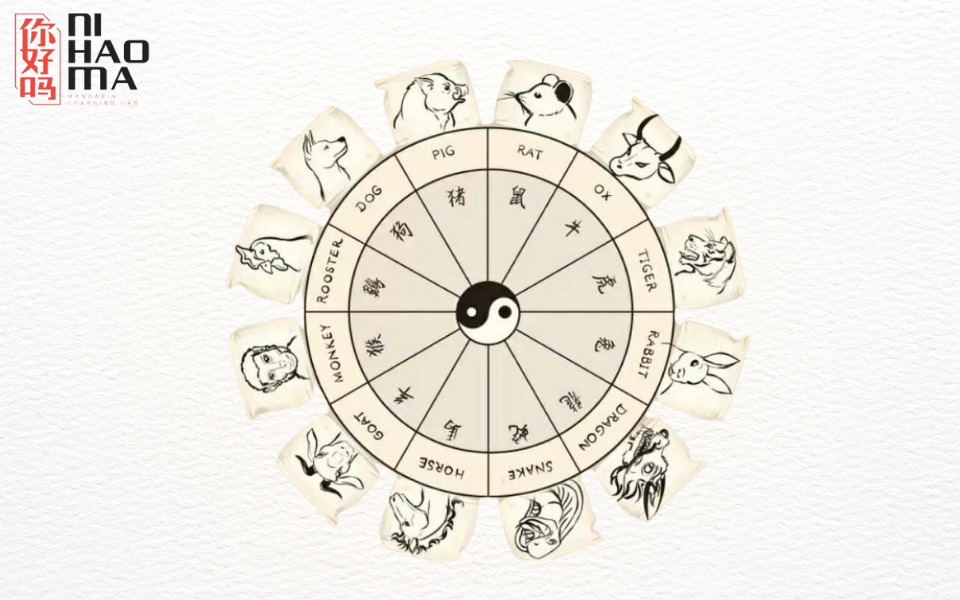
Applications of Time Periods in Chinese
Telling time in Chinese is not just a method of measuring time in traditional Chinese culture; it also has many important applications in various aspects of life.
- Feng Shui: Feng shui is an ancient Chinese practice that focuses on arranging living and working spaces in a way that harmonizes with the natural world. In Feng Shui, telling time plays a key role in determining the right moments to carry out rituals, construction, and activities related to wealth and happiness.
- Performing Rituals and Offerings: Traditionally, rituals, prayers, and spiritual activities must be conducted at specific “auspicious” times. Telling time in Chinese helps determine the most suitable moments for these ceremonies, ensuring peace and prosperity for the family.
- Traditional Chinese Medicine: Telling time in Chinese also has an impact on the principles of Traditional Chinese Medicine (TCM). Each organ in the body is believed to be most active during a specific “time period”, which affects its functioning and health.
Conclusion
Mastering the art of telling time in Chinese is essential for effective communication in both professional and daily life. The article from Ni Hao Ma has provided you with an introduction to how to tell time in Chinese, along with specific examples.
We hope you found this information useful. For more fascinating insights and to enhance your learning, be sure to check out the online and offline Mandarin courses offered by Ni Hao Ma!



